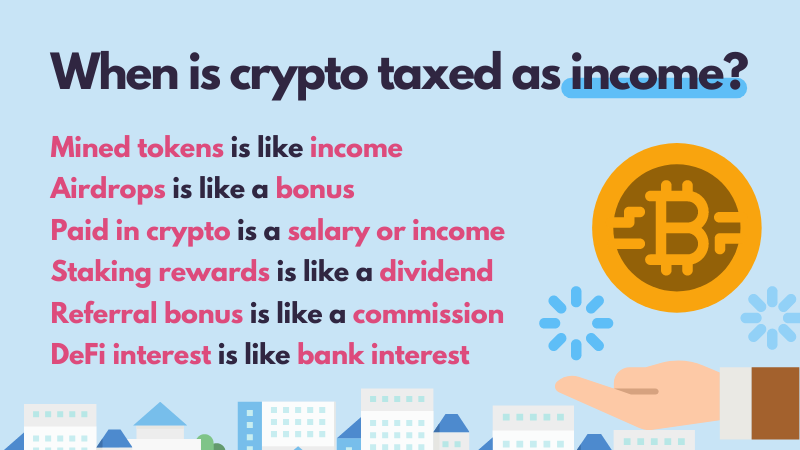How to Calculate Crypto Taxes
Need to know how to calculate your crypto taxes? Your crypto is subject to both Capital Gains Tax and Income Tax - depending on the specific transaction you're making. This means you need to be able to calculate your crypto capital gains and losses, as well as your crypto income, to figure out how much tax you'll pay. Don't worry - both are pretty simple. Let's dive into calculating your crypto taxes.
Crypto Tax 101
A quick reminder on crypto tax before we jump in, there are two types of tax when it comes to crypto - Capital Gains Tax and Income Tax - and you calculate them in different ways.
You'll pay Capital Gains Tax on crypto any time you:
Sell crypto for fiat currency - like USD.
Trade crypto for crypto.
Spend crypto on goods or services.
Gift crypto - in most countries.
 Meanwhile, you'll pay Income Tax on crypto you 'earn', this includes:
Meanwhile, you'll pay Income Tax on crypto you 'earn', this includes:
Referral bonuses.
Hard forks.
Crypto interest.
Many crypto DeFi activities like yield farming and liquidity mining.
 This is a general overview. The rules vary per country so make sure to check your country's crypto tax rules in our crypto tax guides to see how it works where you live. You can also learn more about crypto tax in our Crypto Capital Gains Tax Guide and Crypto Income Tax Guide.
This is a general overview. The rules vary per country so make sure to check your country's crypto tax rules in our crypto tax guides to see how it works where you live. You can also learn more about crypto tax in our Crypto Capital Gains Tax Guide and Crypto Income Tax Guide.
Once you've identified which type of tax applies to your crypto transaction(s) - you need to calculate your profit and the amount of tax you'll pay. We'll look at both - starting with crypto income.
How to calculate crypto income
Crypto income is easy to calculate. All you need to do is take the fair market value of the coins or tokens in fiat currency on the day you received them.
So for example, say you mined Bitcoin. You earned 0.1 BTC and you received it on the 5th of January 2022. The price of 0.1 BTC that day was $3,667. So you have $3,667 in crypto income - which you'll pay Income Tax on at your regular rate.
It's that simple. But remember, just because you've paid Income Tax on crypto doesn't mean you won't pay Capital Gains Tax on crypto should you later sell, trade, spend or gift. So let's look at how to calculate crypto capital gains too.
How to calculate crypto capital gains
Whenever you sell, trade, spend, or gift crypto - you'll have a capital gain or a capital loss. This is the difference in value between when you acquired your crypto and when you sold, traded, spent, or gifted it. If the price has increased, you have a capital gain (profit). If the price has decreased, you have a capital loss.
To calculate a capital gain - you need to start with your cost basis. This is the price you bought the crypto for plus any transaction fees. If you acquired the crypto through other means and don't know the cost basis - use the fair market value of the crypto in fiat currency on the day you received it as your cost basis instead.


$4,200 - $3,667 = $533. You have a capital gain of $533 that you'll need to pay Capital Gains Tax on.
Capital Gains Tax rates vary per country. Some countries have a short-term and long-term Capital Gains Tax rate (like the US), while other countries simply use your Income Tax rate as your Capital Gains Tax rate. Many countries also allow you to earn tax-free capital gains, up to a certain amount each year.
You can check your country's crypto tax guide to find out your crypto Capital Gains Tax rate and Income Tax rates.
Calculating crypto cost basis
So the example we used above actually simplified things. Most crypto investors aren't just mining a small volume of coins and selling one coin a year- otherwise, we wouldn't need crypto tax software. So let's look at another example to explain.
You bought 2 ETH in 2020 and the price of ETH that day was $500. You bought another 1 ETH in 2021 for $3,600. You sold 1 ETH in 2022 for $2,400. If you use the cost basis from the ETH you bought in 2020, you have a $1,900 capital gain which you need to pay Capital Gains Tax on. Meanwhile, if you use the cost basis from the ETH you bought in 2021, you've got a $1,200 capital loss. So how do you know which cost basis to use?
You use a cost basis method. We have a whole article on this - but in brief, a cost basis method tells you which cost base to use when calculating your capital gains and losses. Some countries - like the UK - have strict rules on cost basis methods, while others let you pick from a variety of cost basis methods to use - like the US.
There are a lot of cost basis formulas to choose from around the world, including:
First In, First Out (FIFO): The first asset you buy is the first asset you sell.
Last In, First Out (LIFO): Opposite of FIFO, use the cost basis of the asset you purchased most recently.
Average Cost Basis (ACB): An average cost for all assets, calculate this by adding up the total amount you paid to buy your asset(s) and divide it by the total amount of coins/tokens held.
Highest Cost, First Out (HIFO): Most expensive asset is sold first.
Lowest Cost, First Out (LCFO): The least expensive asset is sold first.
Specific Lot Identification (Spec ID): Pick which asset you sold using TXN numbers.
Loss Gain Utilization (LGUT): Use the cost basis that would result in the largest loss first.
You can find out more about the pros and cons of cost basis methods and which countries allow which cost basis method in our Cost Basis Guide.
Use a crypto tax calculator like Koinly
As you can see - calculating your crypto taxes isn't too difficult. But for many crypto investors with hundreds or thousands of transactions in a given financial year, it's a lot of calculations. You can do your crypto taxes manually by identifying each taxable transaction and calculating your crypto income or capital gains or losses for each transaction. Usually, the easiest way to do this manually is with a spreadsheet and a calculator!
Or you can save yourself hours and use Koinly.
Koinly integrates with crypto exchanges and wallets using API or by uploading a CSV file of your transaction history - letting you track all your crypto transactions from one platform. Better than this, Koinly identifies each taxable transaction and calculates your crypto income and capital gains and losses for you. All you need to do come the tax deadline is download your crypto tax report from Koinly - we offer location-specific reports like the IRS Form 8949 and Schedule D, the UK HMRC Capital Gains Summary, and the ATO myTax report.
Koinly makes crypto tax simple. Try it free today.





